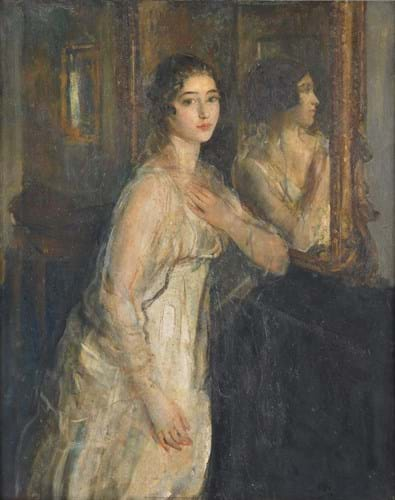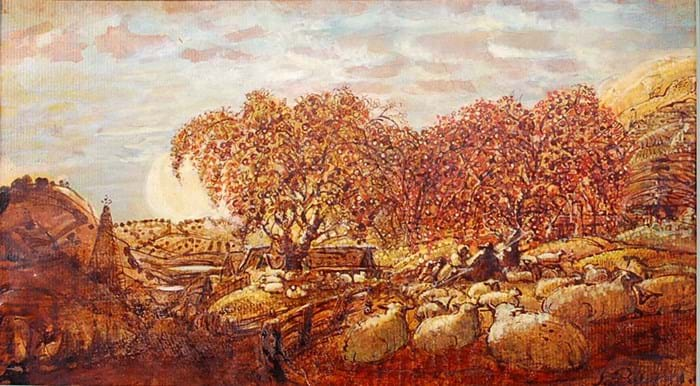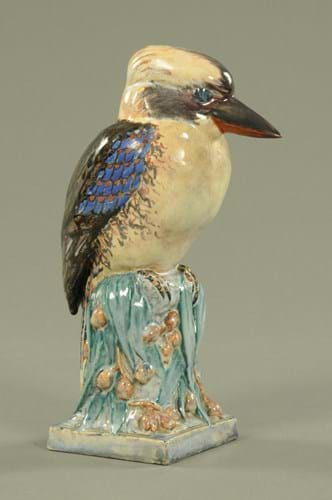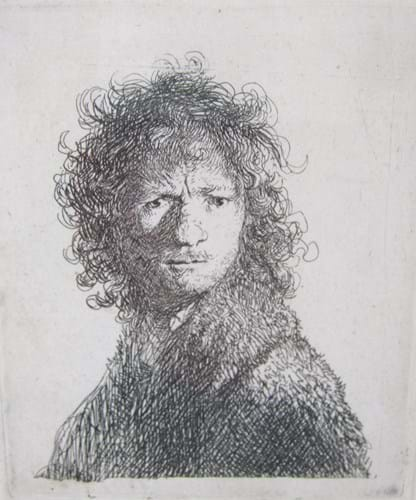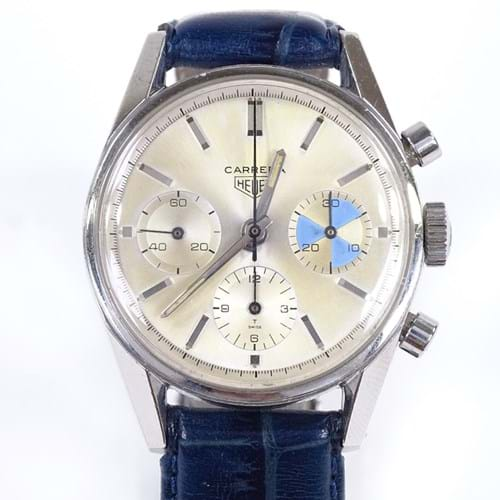1. Ambrose McEvoy painting
Portraits by British ‘society’ artist Ambrose McEvoy (1878-1927) have been commanding increasing attention over recent years.
This 4ft 2in x 3ft 4in (1.27 x 1.01m) oil on canvas portrait (above) of Miss Violet Henry (1901-1976), offered for sale at Dreweatts in Newbury on March 19, was painted in 1918. The sitter was a typical McEvoy client. She was the daughter of Philip Solomon Henry (1863-1933), an Australian copper and coffee trader who later lived first in Paddington and then on a large estate in Asheville, North Carolina. She later married Brigadier Hartley Alfred Macochie and lived in Somerset.
McEvoy painted her standing at a mantelpiece, her reflection appearing in a mirror - a composition borrowed from Whistler's Symphony in White (1864).
The picture has a long exhibition history. Commissioned as part of a series of portraits McEvoy painted to benefit the Red Cross that were shown at the Grosvenor Gallery in 1918, in 1920 it formed part of the McEvoy exhibition held by Duveen in New York that made the artist’s made reputation in the US. It was also pictured in John Rothenstein’s Modern English Painters: Sickert to Smith (1952).
In the family since it was painted, it came for sale in Berkshire with modest expectations of £4000-6000 but its easy-on-the-eye subject and technique found many admirers. It sold to a buyer using thesaleroom.com at £35,000.
2. Landscape by 'faker' Tom Keating
Tom Keating (1917-84) is today fading from notoriety but he remains one of the great English art forgers: he claimed to have faked more than 2000 paintings by over 100 different artists. When in 1970 a group of 13 ‘Samuel Palmer’ Shoreham watercolours were exposed as fakes, he openly confessed to having done them.
Even in his lifetime, Keating's work had become collectable - even Christie's held sales of his work - and the market for his known forgeries continues. This Palmer lookalike showing sheep in a Kent landscape, ‘signed’ lower right, formed part of the sale 'A little bit of Keating’ held by Vost’s in Newmarket in December 1998. It is stamped verso accordingly. It reappeared for sale at Lacy Scott & Knight in Bury St Edmunds on March 21 with an estimate of just £40-60 but sold at £1500.
3. Kookaburra pottery model
Maud O'Reilly (1886-1971), a key figure in Queensland’s Arts and Crafts movement and a student of the LJ Harvey school, showed her pottery at a number of British exhibitions in the mid 1920s. In 1926 she exhibited an 11in (27cm) slip-cast figure of a kookaburra, similar to this one, at The Royal Academy.
A number of versions are known including that sold by Bonhams in Sydney in 2011 for Aus$14,400 (£7323). The example pictured here, incised M O'Reilly 1926, has had some professional restoration to the beak but is in otherwise good condition.
Offered for sale at Mitchells in Cockermouth on March 18, it took £2600 (estimate £2000-3000).
4. Rembrandt van Rijn print
Self-portraits are among the earliest prints that Rembrandt van Rijn (1606-69) made, accounting for a large portion of his etching output when the artist was in his 20s and living in Leiden. Many of these works made prior to around 1630 are studies in physiognomy – character studies or tronies, in which the artist depicted himself shouting or laughing.
This tiny 3 x 2.5in (9 x 7cm) etching, offered for sale by Brightwells in Leominster on March 18, depicts Rembrandt turning his head towards the viewer and frowning. Originally published in 1630 in three different states, this third state print is thought to be a posthumous impression – one of many taken as Rembrandt’s original copper plates were sold and traded in the 18th and 19th centuries.
It has a label to the back for The Fine Art Society, London dated July 8, 1935 and came for sale by descent from WAN Macgeough-Bond, of The Argosy in Dungannon (now a National Trust property). The estimate was just £200-300 but it did rather better, selling for £12,000 – a price more in line with other examples of this etching seen at auction in recent years.
5. Yachting watch
Heuer made several watches for the sailing community in the 1960s – the Seafarer, the Mareograph, the Skipper, the Regatta and this watch the Yachting timer. Part of the Carrera range, it was the first Heuer case with a screw back construction.
This reference 2447S was a special order as it features a custom dial displaying at 3 o'clock three sky blue triangles designed to assist skippers with the 15 minute countdown to the start of a regatta. Only a handful of these watches are known and this example, offered for sale by Burstow & Hewett in Battle, East Sussex on March 18, was in good original condition and in working order.
It was estimated at £2000-3000 but, in a red-hot market for ‘tool’ watches from this period, it took £13,000.


